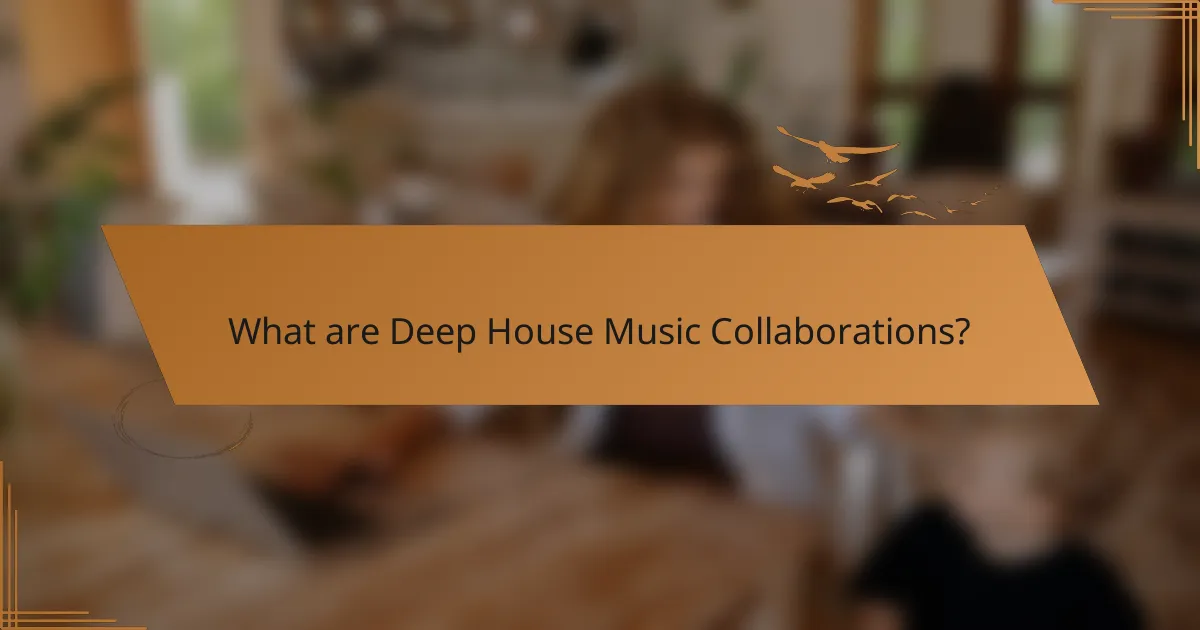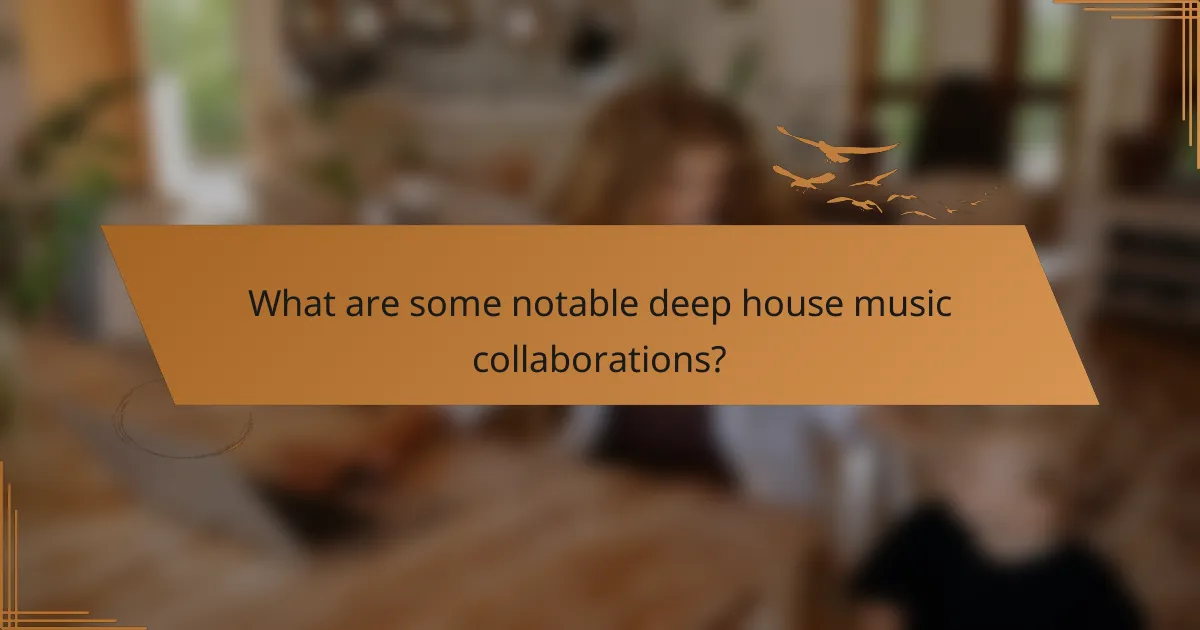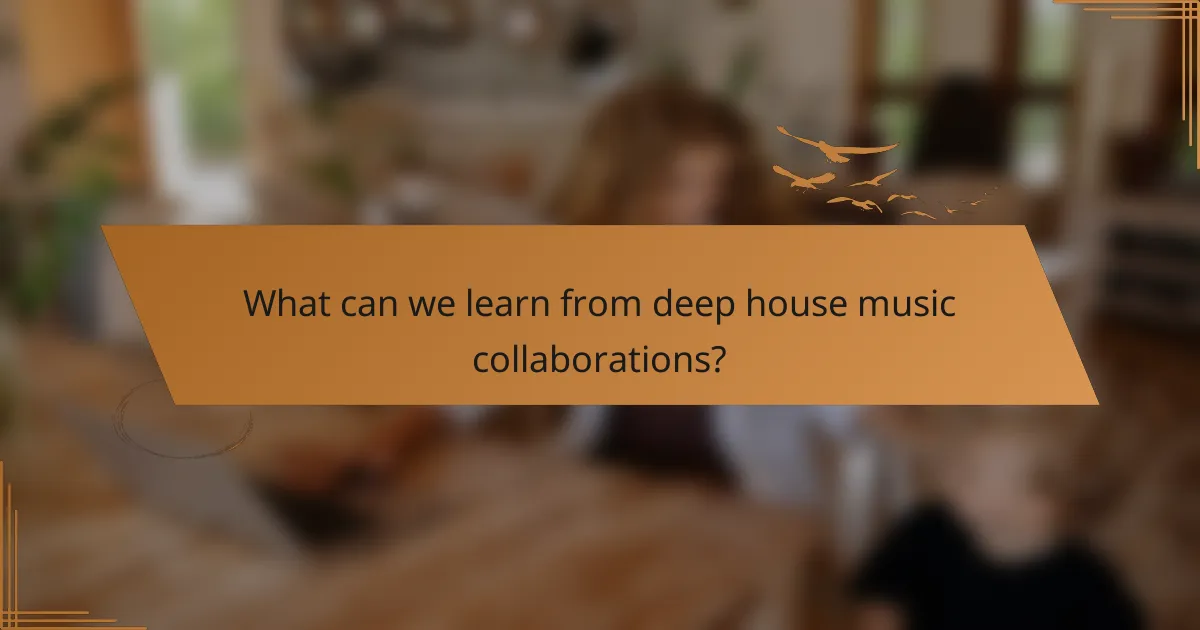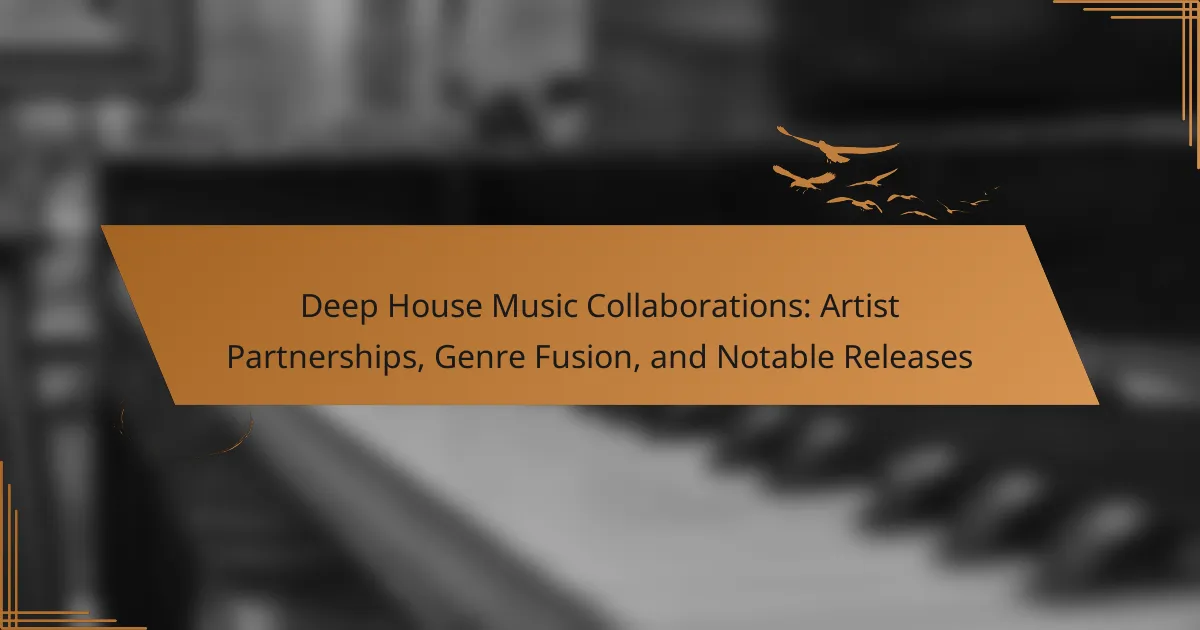Deep House Music Collaborations involve partnerships between artists that create music within the deep house genre, blending various styles and influences to enhance the overall sound. These collaborations can result in tracks, remixes, or live performances that significantly impact the genre’s evolution. Notable examples include “Latch” by Disclosure and Sam Smith, “Can’t Get Enough” by Soulsearcher featuring Michelle Shellers, and “Finally” by Kings of Tomorrow featuring Julie McKnight. Each collaboration showcases the unique fusion of vocal talent and deep house production, illustrating the creativity and innovation that arise from artist partnerships.

What are Deep House Music Collaborations?
Deep House Music Collaborations are partnerships between artists that create music within the deep house genre. These collaborations often blend distinct styles and influences, enriching the overall sound. Artists may work together on tracks, remixes, or live performances. Notable collaborations can lead to significant releases that impact the genre’s evolution. For example, the collaboration between Disclosure and Sam Smith produced the hit “Latch.” These partnerships foster creativity and innovation in deep house music.
How do artist partnerships shape the deep house music scene?
Artist partnerships significantly shape the deep house music scene by fostering innovation and collaboration. Collaborations often lead to unique sounds that blend different musical influences. For example, partnerships between established and emerging artists can introduce fresh perspectives. This results in diverse tracks that appeal to a wider audience. Notable collaborations, such as those between deep house icons and pop artists, have expanded the genre’s reach. Additionally, partnerships can enhance promotional efforts, leveraging each artist’s fan base. This strategic alliance boosts visibility and creates more opportunities for live performances. Overall, artist partnerships are crucial for the evolution and popularity of deep house music.
What roles do featured artists play in collaborations?
Featured artists in collaborations enhance the primary work by adding unique elements. They contribute distinct vocal styles, instrumental skills, or production techniques. This diversity enriches the overall sound and appeal of the track. Featured artists can attract their own fan base, increasing the collaboration’s reach. Their involvement often brings fresh perspectives and creativity to the project. Collaborations can lead to genre fusion, blending different musical influences. Furthermore, these partnerships can result in innovative sounds that push the boundaries of deep house music. Successful collaborations often highlight the synergy between featured artists and primary creators, leading to memorable releases.
How do collaborations influence individual artist styles?
Collaborations significantly influence individual artist styles by introducing new elements and perspectives. When artists work together, they blend their unique sounds and techniques. This fusion often leads to the creation of innovative genres or sub-genres. For example, in deep house music, collaborations can merge elements from techno, jazz, and soul.
Such partnerships encourage artists to experiment beyond their usual boundaries. They gain exposure to different production methods and songwriting processes. This exposure can reshape an artist’s approach to music creation. Notable collaborations in deep house have led to iconic tracks that redefine the genre’s sound.
The impact of collaborations can be seen in the evolution of individual styles over time. Artists often credit their collaborators for inspiring new directions in their music. This dynamic interaction fosters growth and diversification in their artistic expression.
What are the key characteristics of deep house music?
Deep house music is characterized by its smooth, soulful sound and deep basslines. It typically features slower tempos, usually between 120 to 125 BPM. The genre often incorporates elements of jazz, funk, and soul, creating a rich musical texture. Deep house tracks usually include atmospheric pads and lush synths, contributing to a mellow vibe. Vocals in deep house are often soft and emotive, enhancing the overall mood. The genre is known for its use of samples, often from classic tracks, which adds a nostalgic feel. Overall, deep house music emphasizes groove and rhythm, making it suitable for both listening and dancing.
How does tempo and rhythm define deep house tracks?
Tempo and rhythm are essential characteristics that define deep house tracks. Deep house typically features a tempo ranging from 120 to 125 beats per minute. This moderate tempo creates a laid-back yet danceable groove. The rhythm often incorporates syncopated basslines and smooth, flowing beats. These rhythmic elements enhance the genre’s atmospheric and immersive quality. Additionally, deep house tracks frequently utilize extended breakdowns and build-ups. These features contribute to the emotional depth and dynamic progression of the music. The combination of tempo and rhythm establishes the unique identity of deep house, distinguishing it from other electronic music genres.
What elements distinguish deep house from other electronic genres?
Deep house is distinguished from other electronic genres by its unique combination of elements. It typically features a slower tempo, usually ranging from 120 to 125 BPM. The genre is known for its complex chords and jazzy harmonies. Deep house often incorporates soulful vocals and atmospheric sounds. The use of deep basslines is a defining characteristic. It also emphasizes a smooth and laid-back groove. Unlike other electronic genres, deep house tends to create a more immersive experience. These elements contribute to its distinct sound within the broader electronic music landscape.
Why are collaborations important in the evolution of deep house music?
Collaborations are crucial in the evolution of deep house music. They foster innovation by blending diverse musical styles and influences. This genre thrives on creative partnerships that introduce new sounds and techniques. Collaborations often lead to unique tracks that push the boundaries of deep house. Notable examples include artists like Disclosure and Sam Smith, whose partnership produced chart-topping hits. These collaborations expand the audience reach and increase genre popularity. Additionally, they facilitate cross-pollination between deep house and other genres, enhancing its overall richness. Ultimately, collaborations drive the continuous evolution of deep house music.
How do collaborations foster genre fusion?
Collaborations foster genre fusion by merging diverse musical styles and influences. When artists from different genres work together, they bring unique sounds and techniques. This interaction leads to innovative combinations that create new sub-genres. For example, deep house artists collaborating with hip-hop musicians can blend rhythmic elements and vocal styles. Historical examples include the collaboration between Daft Punk and Pharrell Williams, which combined electronic and funk influences. Such partnerships expand the creative possibilities and attract wider audiences. The result is a richer musical landscape that reflects a variety of cultural influences.
What impact do collaborations have on audience reach?
Collaborations significantly enhance audience reach. They allow artists to tap into each other’s fan bases. This cross-pollination can lead to increased visibility and engagement. For example, a collaboration between two popular deep house artists can introduce their music to a wider audience. Research shows that collaborative tracks often achieve higher streaming numbers. A study by Nielsen Music found that collaborations account for a substantial portion of top-charting songs. This demonstrates the effectiveness of partnerships in expanding listener demographics.

What are some notable deep house music collaborations?
Notable deep house music collaborations include “Can’t Get Enough” by Soulsearcher featuring singer-songwriter Michelle Shellers. This track was a major hit in the late 1990s, showcasing the genre’s melodic elements. Another significant collaboration is “Finally” by Kings of Tomorrow featuring Julie McKnight. Released in 2000, it became an anthem in the deep house scene. “Deep End” by John Summit featuring Hayla is a recent collaboration that gained popularity in 2020, further solidifying the genre’s evolution. Additionally, “I Feel for You” by Bob Sinclar featuring the vocals of the late singer-songwriter, is a classic deep house track that exemplifies successful artist partnerships. Each of these collaborations highlights the unique blend of vocal talent and deep house production, contributing to the genre’s rich history.
Which artist partnerships have made a significant impact?
Duke Dumont and Jax Jones have made a significant impact in deep house music. Their collaboration on the track “I Got U” topped charts worldwide. This partnership showcased a fusion of deep house and pop elements. Another impactful duo is Disclosure and Sam Smith. Their song “Latch” gained international acclaim and brought deep house to mainstream audiences. Additionally, the partnership between Gorgon City and MNEK produced “Ready for Your Love,” which became a dancefloor anthem. These collaborations have helped define the sound of modern deep house music. They have also contributed to the genre’s growth and popularity.
What are the standout tracks from these collaborations?
Standout tracks from deep house music collaborations include “Can’t Get Enough” by Soulsearcher and “Cola” by CamelPhat & Elderbrook. “Can’t Get Enough” achieved significant chart success, reaching number one in several countries. “Cola” gained critical acclaim and topped the Beatport charts. Other notable tracks are “I Feel for You” by Bob Sinclar and “Nothing Matters” by Tchami & Malaa. These tracks exemplify the genre’s fusion and collaboration essence. Each track has contributed to the evolution of deep house music, showcasing innovative sounds and artist partnerships.
How have these partnerships influenced the genre’s development?
Partnerships in deep house music have significantly influenced the genre’s development. Collaborations between artists have led to innovative sounds and styles. These partnerships often combine diverse musical backgrounds. For example, collaborations with pop and techno artists have broadened the appeal of deep house. Notable releases often emerge from these joint efforts, showcasing unique blends. The exchange of ideas in partnerships fosters creativity and experimentation. This has resulted in the evolution of sub-genres within deep house. Overall, artist collaborations continue to shape the genre’s direction and growth.
What are some examples of genre fusion in deep house music?
Deep house music often fuses with various genres to create unique sounds. One prominent example is deep house combined with jazz, leading to tracks that feature live instrumentation and complex harmonies. Another example is the fusion of deep house with soul, which incorporates rich vocal performances and emotive lyrics.
Additionally, deep house has merged with techno, resulting in a more driving beat and darker atmosphere. The blend of deep house with ambient music creates soothing soundscapes, ideal for relaxation.
Furthermore, collaborations between deep house artists and hip-hop musicians have produced tracks that blend rhythmic elements and vocal styles. These genre fusions showcase the versatility and evolving nature of deep house music.
How does deep house incorporate elements from other music styles?
Deep house incorporates elements from other music styles through its diverse influences. It blends aspects of jazz, funk, and soul, creating a rich soundscape. The use of complex chords and melodic patterns often reflects jazz influences. Funk contributes rhythmic grooves and basslines that enhance the danceability of deep house tracks. Soul elements manifest in vocal styles and emotional delivery, adding depth to the music. Additionally, deep house integrates electronic music techniques, such as sampling and synthesizers. This fusion results in a unique genre that appeals to a wide audience. The genre’s evolution showcases collaborations with artists from various backgrounds, further enriching its sound.
What are some successful genre-blending collaborations?
Successful genre-blending collaborations in deep house music include notable partnerships like Disclosure and Sam Smith. Their track “Latch” combines electronic and soul elements, achieving commercial success. Another example is Duke Dumont’s collaboration with Jax Jones on “I Got U,” which blends deep house with tropical house influences. This song topped charts and received widespread acclaim. Additionally, the collaboration between Calvin Harris and Dua Lipa on “One Kiss” merges deep house with pop, becoming a massive hit. These collaborations demonstrate the versatility and appeal of genre fusion in deep house music.

What can we learn from deep house music collaborations?
Deep house music collaborations teach us about the blending of diverse musical styles. Collaborations often result in innovative sounds that push genre boundaries. They highlight the importance of synergy between artists. Each artist brings unique influences and skills to the project. This fusion creates a richer listening experience. Notable collaborations often lead to chart-topping hits. For instance, the collaboration between Disclosure and Sam Smith produced “Latch,” which gained international acclaim. These partnerships can also enhance an artist’s reach and fan base. Overall, deep house collaborations demonstrate the power of creativity and cooperation in music.
What best practices can artists follow when collaborating?
Artists should communicate clearly and openly when collaborating. Establishing mutual goals helps align creative visions. Setting deadlines ensures timely progress on the project. Respecting each other’s artistic input fosters a positive working environment. Sharing responsibilities can enhance the collaborative process. Documenting agreements protects the interests of all parties involved. Regular check-ins allow for adjustments and feedback throughout the collaboration. These practices lead to successful and productive artistic partnerships.
How can artists effectively communicate during a collaboration?
Artists can effectively communicate during a collaboration by establishing clear roles and expectations. This involves discussing individual contributions and creative visions upfront. Regular check-ins help maintain alignment and address any issues promptly. Utilizing digital tools for sharing ideas and feedback enhances communication efficiency. Active listening is crucial, as it fosters mutual respect and understanding. Open dialogue encourages experimentation and creativity. Documenting decisions ensures everyone is on the same page. Studies show that effective communication can lead to more successful artistic outcomes, as seen in various collaborative projects within the music industry.
What strategies can enhance creative synergy between artists?
Collaborative workshops can enhance creative synergy between artists. These workshops provide a space for artists to share ideas and techniques. Regular brainstorming sessions also foster open communication and innovation. Cross-genre collaborations encourage artists to explore new sounds and styles. Utilizing digital platforms facilitates remote collaboration and idea sharing. Feedback loops allow artists to refine their work through constructive criticism. Networking events create opportunities for artists to connect and collaborate. Lastly, setting shared goals aligns artists towards a common creative vision.
What trends are emerging in deep house music collaborations?
Emerging trends in deep house music collaborations include increased genre fusion and cross-genre partnerships. Artists are blending deep house with elements from techno, disco, and even pop. This fusion creates fresh sounds appealing to broader audiences. Additionally, collaborations between established and emerging artists are on the rise. Notable examples include partnerships that leverage social media for promotion. Collaborations are also featuring diverse vocalists, enhancing the emotional depth of tracks. The use of virtual collaborations has increased, especially post-pandemic. These trends reflect a dynamic and evolving landscape in deep house music.
How are technology and social media influencing collaborations?
Technology and social media are significantly enhancing collaborations in deep house music. They enable artists to connect instantly regardless of geographical barriers. Platforms like SoundCloud and Instagram facilitate sharing music and ideas. This instant communication fosters creative partnerships. Collaborative tools allow for real-time editing and feedback on tracks. Social media also helps artists promote their collaborations to wider audiences. Data shows that tracks released through social media channels gain more visibility. This increased exposure can lead to more successful collaborations and genre fusion.
What future directions might deep house collaborations take?
Future directions for deep house collaborations may include increased genre fusion. Artists are likely to blend deep house with elements from techno, jazz, and world music. This trend can create innovative sounds that appeal to broader audiences. Additionally, collaborations may leverage technology for remote production. Tools like virtual studios enable artists from different locations to work together seamlessly. The rise of social media can also enhance collaboration opportunities. Artists can connect with each other and their fanbase more effectively. Furthermore, collaborations may focus on sustainability and social issues. This shift can influence the themes and messages in their music. Overall, these directions indicate a dynamic evolution in deep house collaborations.
Deep House Music Collaborations are partnerships between artists that create music within the deep house genre, blending distinct styles to enrich the overall sound. This article explores how artist partnerships shape the deep house music scene, the roles of featured artists, and the influence of collaborations on individual artist styles. Key characteristics of deep house music, including tempo, rhythm, and genre fusion, are discussed alongside notable collaborations that have impacted the genre’s evolution. Additionally, the article highlights emerging trends in collaborations and the influence of technology and social media on the creative process.
